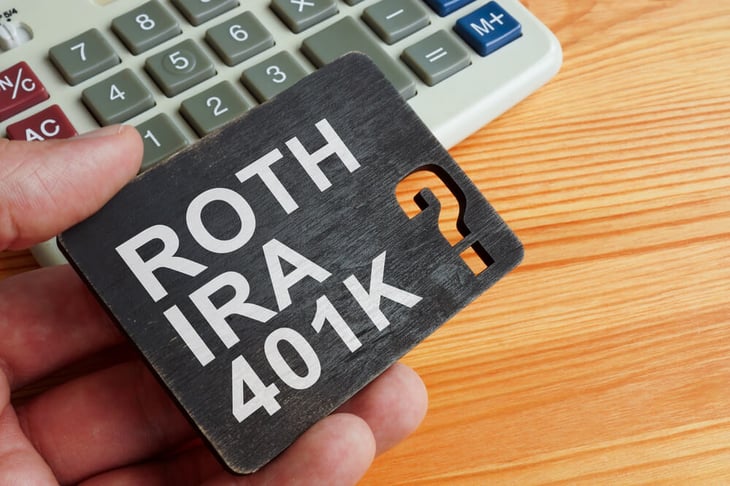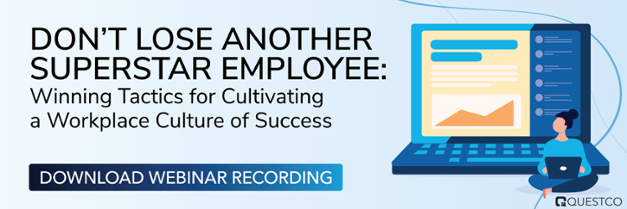Topic Employee Benefits,
How to Reduce the Risks of Offering Retirement Benefits

July 18, 2023 | By Questco Companies

In today's competitive job market, businesses of all sizes are recognizing the need to offer robust retirement benefits like 401(k) contributions.
Navigating these retirement plans' legal requirements and administrative burdens can be daunting for businesses without a whole in-house HR department.
Luckily, retirement benefits aren't just for Fortune 500 companies anymore
This dramatic shift in the benefits landscape is primarily due to entities known as Professional employer organizations, or PEOs. These organizations have transformed how small to medium-sized businesses approach employee benefits, particularly employer-sponsored retirement plans.
But what is a professional employer organization?
A PEO is a firm that provides comprehensive HR outsourcing solutions. They manage various tasks, including payroll, employee benefits, tax filing, and regulatory compliance.
When it comes to offering retirement benefits, PEOs minimize risk through:
- Compliance expertise
- Administrative support
- Cost savings
- Risk management
- Dispute resolution
- Benefits design
- Employee education
Having these safeguards in place is critical, but to truly understand a PEOs' value, a closer look at the risks involved in offering retirement benefits is necessary.

The Risks of Offering Retirement Benefits
Understanding the risks of offering 401(k)s is the first step to effectively managing them.
The first hurdle to overcome lies in the intricacies of legal and regulatory compliance. Many laws govern the administration of retirement benefits, from the Employee Retirement Income Security Act (ERISA) to IRS guidelines. These laws dictate everything from reporting requirements and disclosure obligations to fiduciary responsibilities.
Straying from these rules, even unintentionally, can lead to costly penalties and potentially damage your company's reputation.
Then, there's the financial risk.
Offering retirement benefits, particularly defined benefit plans or 401(k) contributions, represents a significant financial commitment. These costs can fluctuate based on factors like market performance and employee longevity. Without proper planning and risk management, these fluctuations can substantially impact your company's bottom line.
Additionally, proficient administration and systematic record-keeping are essential when offering retirement benefits. These tasks include managing enrollments, tracking contributions, and ensuring distributions follow the correct rules and timelines. Any errors or oversights can lead to employee dissatisfaction, costly corrections, and potential lawsuits.
Understanding these challenges paints a clear picture of the risks of offering retirement benefits. But it's not all doom and gloom. With the proper support, these risks can be effectively managed.
For example, when you partner with a PEO, you no longer have to stress about compliance requirements.
Compliance Expertise
A single misinterpretation of a retirement plan document can escalate into a full-blown audit by the Department of Labor (DOL) or the Internal Revenue Service (IRS).
Professional employer organizations play an instrumental role in ensuring compliance with the Employee Retirement Income Security Act (ERISA). This act, the leading legislation governing retirement plans, has stringent rules often misinterpreted or overlooked, leading to potential violations.
In fact, three out of four plans audited by the Employee Benefits Security Administration (EBSA), a branch of the DOL, detected an ERISA violation.
A significant part of ERISA compliance involves maintaining and understanding key documents. This includes the most recent plan document and any amendments.
Compliance problems can also arise by inadvertently excluding eligible employees from participating or using ineligible compensation to determine participants' deferrals.
Misunderstandings can also arise with the role of third-party administrators (TPAs). Employers sometimes assume that TPAs are responsible for certain functions, such as vesting calculations and the approval of participant loans and distributions, which actually fall within the employers' purview.
PEOs can help manage these responsibilities, ensuring that they are carried out correctly and in accordance with the plan document and IRS regulations.
As we venture further into the value that PEOs bring to the table, we'll explore how these organizations simplify retirement benefit administration, paving the way for a smoother, more confident journey toward offering these benefits.

Administrative Efficiency
PEOs don't manage administrative tasks simply because they're experts. They do it because it saves employers time, money, and a lot of stress.
When it comes to offering retirement benefits, the list of tasks that need managing can seem endless.
Take a 401(k), one of the most common employer-sponsored retirement plans. PEOs manage several administrative tasks tied to this benefit. They handle the annual discrimination audit testing, an essential process to ensure the plan doesn't unfairly favor highly compensated employees. They also manage loan deductions and reviews, a crucial task to keep track of loans taken against retirement benefits by employees.
Another task that falls under the purview of PEOs is the reconciliation of safe harbor contributions.
Safe harbor contributions are employer contributions that are fully vested when made, and their reconciliation ensures these contributions are correctly calculated and allocated.
PEOs also handle the Form 5500 filing, a yearly report that provides information about the plan's financial conditions, investments, and operations.
Lastly, PEOs oversee distributions, or the payments made from a retirement plan. They ensure these distributions are made in compliance with plan terms and federal regulations.
By taking care of these tasks, PEOs allow businesses to focus more on their core operations and less on administrative work. This leads to a lower risk of errors and, consequently, a lower risk of costly penalties or lawsuits. But the role of PEOs in managing retirement benefits doesn't stop at administration; PEOs can create cost savings for businesses offering retirement benefits.
Cost-Effectiveness
The cost of offering retirement benefits can be prohibitive for some companies. The complexity of these plans often means high administrative costs and financial risk if investments don't perform as expected.
But that's where a PEO's bargaining power comes in.
With many clients under their wing, PEOs can negotiate better rates with financial institutions and retirement plan providers. These cost savings can be significant, making retirement plans more affordable for employers and reducing the financial risk of offering these benefits.
But the cost savings aren't limited to just the price of the plans.
By managing these retirement benefits, PEOs can also save employers the cost of hiring additional staff or investing in specialized software.
The result?
An affordable, well-managed retirement benefit plan that's attractive to employees and manageable for employers.
Yet, the world of retirement benefits doesn't stand still. Laws change, new financial products are introduced, and employee expectations evolve.
How can employers stay ahead of the curve?
This is where the next role of PEOs comes into play - risk management and dispute resolution.

Dispute Resolution and Risk Management
When it comes to the complexities of retirement benefits, it's not uncommon for misunderstandings and miscommunications to arise. An employee may question the employer's matching contributions to their 401(k) plan, or there could be confusion over the withdrawal terms of a Roth IRA.
Disputes, while not the norm, occasionally occur. When they do, they can cause significant stress for all parties involved.
The goal of a PEO in dispute resolution is to ensure a fair and satisfactory outcome for both you and your employee, maintaining a harmonious working environment.
Beyond handling disputes, PEOs also help manage risk through proactive measures. These include regular audits of retirement plans, keeping track of individual retirement accounts, and ensuring timely and accurate pension payments.
Through their meticulous work, PEOs mitigate the risk of discrepancies and errors, reducing the chance of disputes arising in the first place.
But what about the intricacies of designing a retirement benefits package that balances employee satisfaction with financial and legal feasibility?
PEOs have that covered too.
Benefits Design and Employee Education
Offering a robust package is vital for attracting and retaining talent, but it must also be sustainable for the business. With their extensive knowledge, PEOs are well-equipped to help companies to create an optimal mix of options like pension plans, 401(k) contributions, and Individual Retirement Accounts (IRAs), all tailored to fit the company's financial capabilities.
However, design is only half of the battle.
It's equally important that employees understand their benefits - what they are, how they work, and why they're valuable.
After all, a benefit that isn't understood or used is hardly a benefit at all.
To tackle this, PEOs provide education initiatives, ensuring employees clearly understand the benefits on offer. Whether it's Social Security benefits or the advantages of a Roth IRA, PEOs can help demystify these concepts, enhancing employee satisfaction and appreciation of their retirement packages.
Employers can breathe a sigh of relief knowing that the design and education aspects of retirement benefits are in the capable hands of a PEO.
Reducing the Risk of Employee 401(k) Plans
PEOs can secure better rates for retirement plans such as 401(k) contributions, pension plans, and individual retirement accounts (IRAs) while efficiently managing the associated risks.
Through their professional approach, PEOs serve as a sturdy bridge between employers and employees, streamlining communication and resolving issues easily and efficiently.
PEO expertise in designing retirement benefits packages and educating employees further mitigates potential risks. By ensuring employees understand the nuances of their retirement income, Social Security benefits, and other aspects of their retirement savings, PEOs help foster a culture of transparency and trust.
Ultimately, collaborating with a PEO to manage retirement benefits is akin to investing in a safety net. It is about safeguarding both your and your employees' interests.
So, while venturing into offering retirement benefits, remember that you don't have to go it alone.



